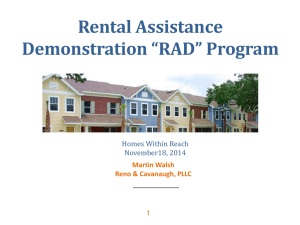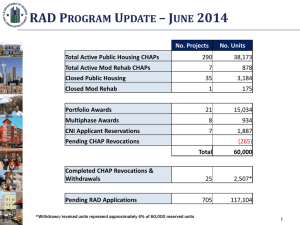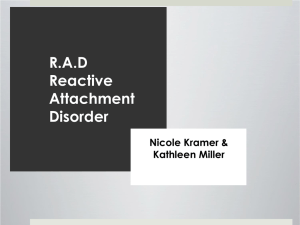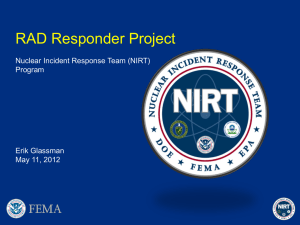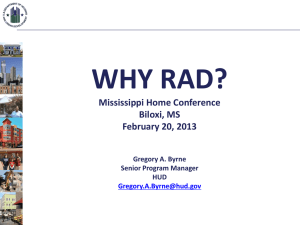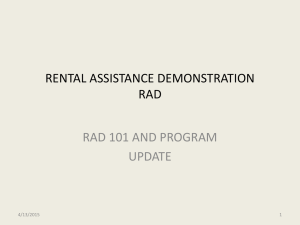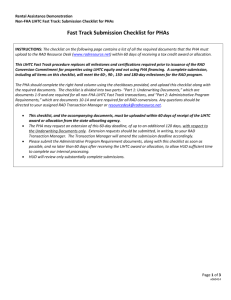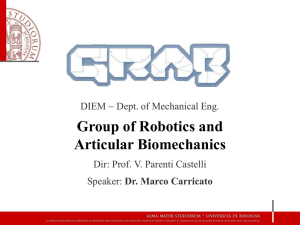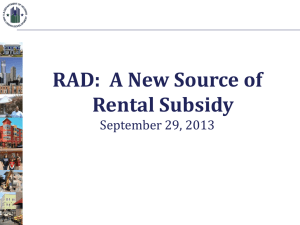RAD Capital Needs Assessment Presentation
advertisement
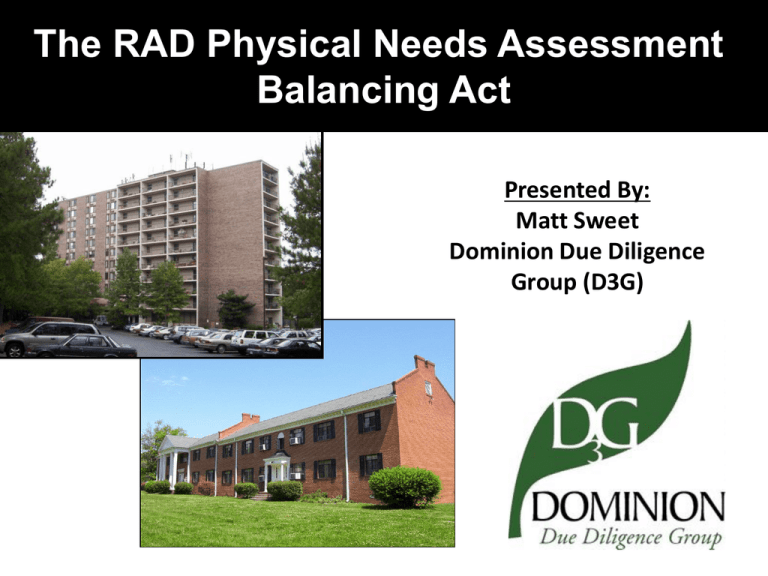
The RAD Physical Needs Assessment Balancing Act Presented By: Matt Sweet Dominion Due Diligence Group (D3G) The RAD Strategy There are three basic strategies for completing a RAD conversion - Direct take out - Preservation Deal - Rehab strategy - LIHTC A Physical Needs Assessment* is a study which defines immediate and long-term capital needs; and typically includes: - Property Inspection Report - Identification of Immediate Repairs - Reserve for Replacement (R4R) Analysis * PNA, PCA, PCNA, PCR synonymous in the above definition. The RAD PCNA • Three (3) Scopes of Work in One Assessment o Green PCNA + Energy Audit + UCB • Selecting your PCNA provider o Qualifications o Experience with mixed financing and MAP o Scope and timing • Deliverables o Report + Excel Tool It is key to understand the RAD Excel Tool functions & objectives Driving Factors in a Physical Needs Assessment - Property Condition - Funding Sources - Ownership Direction/Expectation Sometimes synergies, sometimes conflict Property Condition Considerations • • • • Age of Asset and Physical Condition Level of rehab planned versus what is necessary Building code issues (life safety, fire, electrical, etc.) Hidden, latent defect or other conditions warranting intrusive study (long lived building components) • Environmental conditions • Sources of Loan and Financing Accessibility Issues (UFAS, ADA Title II) LIHTC QAP Requirements Lender / Syndicator Requirements The Yin & Yang of RAD & LIHTC SOURCES USES or NEEDS The Balancing Act Equity or Loan Sources • LIHTC QAP Architectural Baseline Standards • LIHTC QAP Scoring Architectural Items • Housing Assistance Contracts (PBRA, PBVA) • Housing for the Elderly or other designation • Syndicator Requirements • Permanent Loan Program Requirements • Future Reserve for Replacement (R4R) Deposits (e.g. a 100 unit complex at ADRR of $350/unit= $700,000 + interest over 20 year period) Expectations (aka “Establishing the Target”) • What are the owner expectations? • Pro-forma projected Per Unit Per Annum (PUPA) or Annual Deposit to the Replacement Reserves (ADRR) • Energy Water Conservation Measures? • And the $60,000 Question is: “Sources allow for how much rehabilitation?” When and Where do Accessibility Regulations Apply? MARKET RATE APARTMENTS Fair Housing Act Requirements AFFORDABLE (not assisted, e.g. LIHTC's) Fair Housing Act Requirements FEDERALLY ASSISTED** Fair Housing Act & 504/UFAS Requirements Projects built from 7/11/1988 to 3/13/1991 None None 504/UFAS Requirements Sub Rehab of projects built before 7/11/1988 None ADA Title II 504/UFAS Requirements (subjected to 8.23(b) other alterations, as applicable; load bearing wall exception) Refinance of projects built prior to 7/11/1988*** None None 504/UFAS Requirements (load bearing wall and financial/administrative burden exceptions All Public Accommodation ADA ADA ADA & 504 UFAS ACTIVITY & YEAR BUILT Projects built (1st occupancy*) after 3/13/1991 RAD Common Issues 1. Properties may not have an accurate assessment of needs 2. Perception vs. Reality (Preservation vs. Asset Management) 3. Lack of property details (build date, SF, #bldgs, off-site...) 4. “Over-housed” conditions and reclassifying rents 5. Functional obsolescence issues (EUL, RUL, and REL) 6. Misperceptions of RAD and bad press 7. Energy Data, EWCM Implementation, and Utility Allowances 8. EPCs or CFFP in place 9. Municipality Involvement (pre and post conversion) RAD Lessons Learned 1. RAD is not easy, much like LIHTC with more layers 2. Identify “expectations” and “goals” early on to meet milestones 3. Identify available/predictable sources of funding 4. Remember long-lived building systems (ML 2012-25) 5. DBWR cannot be avoided (even in a LIHTC pilot!) 6. Get to know your Transactions Manager (TM) 7. Request concept meeting for RAD projects going FHA 8. Review HUD’s RAD FAQs frequently 9. Coordinate Environmental Site Assessment early Environmental Items Common Environmental Studies in affordable housing finance: • Phase 1 Environmental Site Assessment • 24 CFR Part 50 Review • 24 CFR Part 58 Review • Hazardous Material Inspections • NEPA Specialty Studies (Noise; STC Calculations; Floodplains/Wetlands 8-Step Process; ASD Studies; Archeological Studies; Endangered Species…etc.) Creativity in RAD 1. Rebranding of a PHA 2. Making small work for all 3. Portfolio analysis to create synergies / rent bundling 4. The Preservation balance of IDRR and ADRR 5. Reducing expenses through energy upgrades 6. Use of Section 18 Demo Disposition 7. Complexity is the “normal”, examples being: a. RAD conversion; sell with land-lease; and build new b. 15 projects in one bond deal c. 157 scattered site townhomes in an inner-city location
